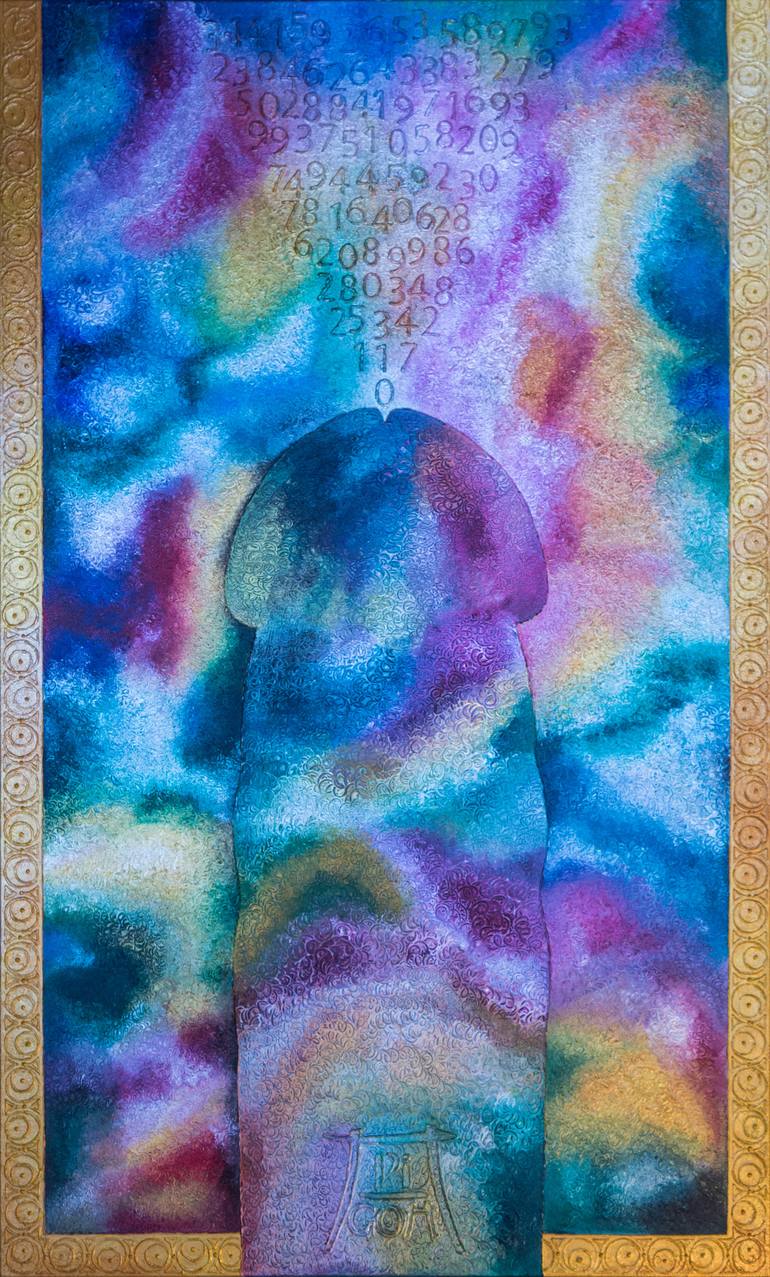


VIEW IN MY ROOM
The Myth of Creation” The Marriage of Phidelity and Pious Painting
Painting, Acrylic on Canvas
Size: 35.8 W x 59.8 H x 1.6 D in
Ships in a Crate
Shipping included
14-day satisfaction guarantee
Artist Recognition

Artist featured in a collection
About The Artwork
The Myth of Creation” The Marriage of Phidelity and Pious Most ancient civilisations and early societies developed cosmogonical accounts of the beginning of their worlds. The Ancient Egyptians, the Greeks, the Aborigines and the American Indians, to name but a few, all had creation stories which were passed down through the generations by oral traditions. And many of these stories involved ekpyrotic models based on cyclical nature of their environments.This painting continues these traditions and in a deliberate primitive style invokes the ‘magic’ of human reproduction by way of explanation. In this context therefore the picture is no more than the equivalent of a primitive art which glorifies the phallus as a source of mystical power. In this modern myth story, the original text, entitled, ‘The Biology of Cosmology’, interpreted the image in terms of a Woman called Creation who fills all of the void within the frame. Creation elopes with Pious, the god of pi, who, enchanted by her beauty and mystery, displays his love for her. In return, Creation summons Space in order for them to be – and to be together; and Pious, with his introduction of pi, invents Infinity so they can have Time together. The text had a happy ending; for together they gave birth to the Universe. It’s a good story. However, I believe, as I have demonstrated in other paintings, there should be two numbers at work to bring existence into being – pi (3.141…) and Phi – (1.618…). So with further consideration, I have changed the title from ‘The Biology of Cosmology’ to ‘The Marriage of Phidelity and Pious’. It’s still a kind of Myth story but perhaps a little more accurate – if a Myth can ever be accurate. In the new story, Phidelity (Phi-delity), becomes the goddess of Truth and represents the Number 1.618…, whilst Pious, respects the Good expressed in the Number 3.141….These are the two lovers and in marriage they give birth to existence.
Details & Dimensions
Painting:Acrylic on Canvas
Original:One-of-a-kind Artwork
Size:35.8 W x 59.8 H x 1.6 D in
Frame:Not Framed
Ready to Hang:Not applicable
Packaging:Ships in a Crate
Shipping & Returns
Delivery Time:Typically 5-7 business days for domestic shipments, 10-14 business days for international shipments.
Handling:Ships in a wooden crate for additional protection of heavy or oversized artworks. Crated works are subject to an $80 care and handling fee. Artists are responsible for packaging and adhering to Saatchi Art’s packaging guidelines.
Ships From:United Kingdom.
Customs:Shipments from United Kingdom may experience delays due to country's regulations for exporting valuable artworks.
Have additional questions?
Please visit our help section or contact us.
Robert Pigott was born in the UK in 1948, in Brigg, Lincolnshire and educated at Brigg Grammar. Following the Art Foundation course at Leicester College of Art he moved to Stockport in Greater Manchester to study Art and Design for Advertising. In 1971 he won a scholarship with the advertising agency, J.Walter Thompson in London, and remained there as Art Director for several years. During this time, he studied painting with the artist Rudolf Ray in London and in Mexico. Ray, whose work had been praised by fellow Austrian, Oskar Kokoschka, was an important influence. (Ray had previously worked with Marcel Duchamp in Paris and was to accompany him to New York in 1942, where Duchamp introduced Ray to Peggy Guggenheim). Despite the early encouragement from Ray it was only very much later that the process of art was taken more seriously. He is currently dividing his time between painting and researching and writing a new book entitled, The Nazareth Parallel, a radical work which blurs the boundaries between Science and Religion. Many of his paintings are used in the book to illustrate his unique ideas and concepts. The painting Ananke is used on the cover design. For more information go to the artist's website at robertpigott.com About The Art Painting is a search tool, a telescope, a probe, a scientific instrument directed inwards to view the soul of the individual, the soul of Man and the metaphysical world. The canvas, the painting is a direct expression of the probing, the image captured by the telescope's long exposure to the space within and the mystery of existence. My own need for certainty in the world became the catalyst for a new period of creativity. I considered that through the deliberate use of painting as a tool, its probing potential could be directed to answer the more funadamental questions about ourselves and our world, the notion that painting can be included as a way of enquiry about our world just as, in the same way, Science makes sense of the nature of things around us. In the time of the Renaissance Art and Science were not separated as they are today but were considered as one discipline. In 1954 Herbert Read considered the role of the artist was to retire within oneself, to reach down into the well of consciousness, in an attempt to reach sources of inspiration that do not belong to our time and civilisation, but are archetypal and universal.
Artist Recognition

Artist featured by Saatchi Art in a collection
Thousands Of Five-Star Reviews
We deliver world-class customer service to all of our art buyers.
Global Selection
Explore an unparalleled artwork selection by artists from around the world.
Satisfaction Guaranteed
Our 14-day satisfaction guarantee allows you to buy with confidence.
Support An Artist With Every Purchase
We pay our artists more on every sale than other galleries.
Need More Help?